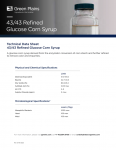Study flags up texture challenges for sweeteners in baked goods
The study – published in LWT - Food Science and Technology – evaluated of the effects of the presence of different sweeteners on the mechanical and rheological properties of doughs for sweet baked goods, finding that non-calorific sweeteners had negative impacts on the texture and rheology of the products when compared to those made with sugar.
The researchers, led by Manuela Mariotti from the University of Milan, Italy, reported that doughs containing the sweetener sucralose showed mechanical and rheological properties “very similar to those of the dough produced with no added sugars.”
The team noted that although food industry expresses “a growing interest in sucrose substitutes to be used in low-sugar products .... when the sugar content is changed, food rheology and texture may be negatively affected.”
Mariotti and her colleagues said products produced with alternative sweeteners were: “firmer, more resistant to tensile forces and less viscous than the doughs containing sucrose or fructose.”
“The use of alternative sweeteners, especially high-intensity sweeteners, has to face with the technological challenge of a complete substitution of sucrose properties: sweetening, bulking, binding, texturing, fermenting etc,” wrote the resarchers.
“This is the reason why other ingredients – such as bulking agents – should be added to low-sugar baked goods to compensate sucrose functionalities complementary to sweetening.”
Sugar replacement
Sugar (sucrose) is one of the most important nutritive sweeteners in the food industry.
“In addition to bulk, it provides a clean sweetness without off flavors; it is available in a wide variety of types and grain sizes to meet the particular requirements of various foods and it is still the most common sweetener in baked goods,” said Mariotti and her team.
However, they noted that in recent years, the food industry has expressed a growing interest in sucrose substitutes, “as a response to the public interest in low-calorie products.”
As a result there has been great interest in using low-calorie sweeteners such as sucralose, aspartame, and stevia (among others) in bakery products. However many of these sweeteners provide challenges for industry during reformulation because they do not provide a like-for-like replacement of sugar – for example there are issues relating to bulking, and differing flavour profiles.
Sweeteners in snacks...
FoodNavigator.com and sister site BakeryAndSnacks.com are hosting a free virtual conference on bakery formulation featuring speakers from Danisco, Datamonitor and Arla today.
The show will include a presentation from Datamonitor experts on the trends for the use of the natural sweetener stevia in bakery products.
Figures from Datamonitor shows that snacks made up 38.5% of new stevia-sweetened products between 2005 and 2009, however it is well known that the sweetener is not To
To learn more about the potential of the sweetener in bakery and snacks market, tune into today's event - BakeryFormulation 2012 - where we ask if the market is ready to embrace stevia in categories such as crisps and crackers.
It is free to register for the virtual conference - just CLICK HERE.
Study Source: LWT - Food Science and Technology
Published online ahead of print, doi: 10.1016/j.lwt.2012.03.001
“About the use of different sweeteners in baked goods. Influence on the mechanical and rheological properties of the doughs”
Authors: M. Mariotti, C. Alamprese


















